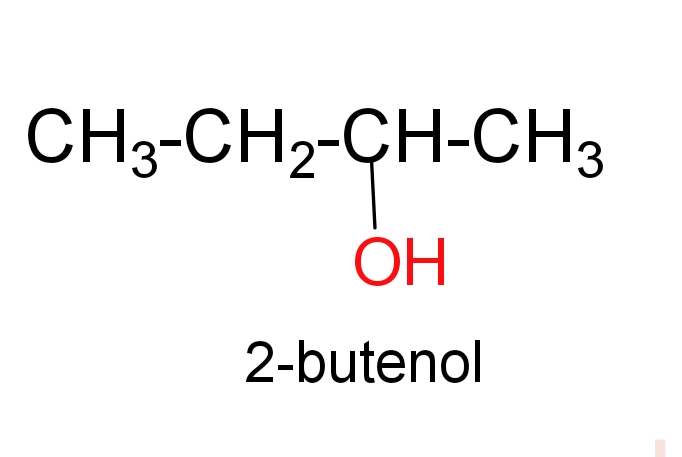
How would you draw the product of the hydration of$\text{2-butene}$?
Answer
554.1k+ views
Hint $\text{2-butene}$ Is a four carbon containing unsaturated hydrocarbon molecule, which have double bond in between ${{\text{C}}_{\text{2}}}\text{-}{{\text{C}}_{\text{3}}}$ carbon atom.
Alkene is an electron rich centre, so electrophilic addition reaction is the characteristic reaction of alkene.
Addition of water molecules in the presence of acid is known as hydration of alkene. During hydration $\text{ }\!\!\pi\!\!\text{ -bond}$ of alkene is broken and formation of $\text{C-H and C-OH}$ takes place.

Complete Step by step solution –
Hydration product of $\text{2-butene}$leads to the formation of$\text{2-butanol}$. $\text{2-butanol}$ Is a four carbon saturated alcoholic compound in which hydroxyl group is attached in ${{\text{2}}^{\text{nd}}}$carbon of butane chain.
Two draw$\text{2-butanol}$, firstly we will draw a four carbon saturated carbon chain and attached $\text{(-OH)}$ group in the second carbon atom.

Additional information –
During the addition of an unsymmetrical reagent we follow the Markownikoff ‘s rule. According to this rule the negative part of the unsymmetrical reagent adds to a less hydrogenated or more substituted carbon atom of the double bond and positive part adds with the less substituted part of the double bond.
Addition of $\text{HBr}$to an alkene in the presence of peroxide is an example of electrophilic addition reaction. It does not follow the markownikoff’s rule during the addition of electrophile in the unsymmetrical alkene. Alcohol is chemically hydroxy derivative of alkane.
Note – All the examples of electrophilic addition reactions involve the formation of stable carbocation leading to the formation of stable carbocation leading to the formation of addition products according to the markownikoff’s rule.
Alkene is an electron rich centre, so electrophilic addition reaction is the characteristic reaction of alkene.
Addition of water molecules in the presence of acid is known as hydration of alkene. During hydration $\text{ }\!\!\pi\!\!\text{ -bond}$ of alkene is broken and formation of $\text{C-H and C-OH}$ takes place.

Complete Step by step solution –
Hydration product of $\text{2-butene}$leads to the formation of$\text{2-butanol}$. $\text{2-butanol}$ Is a four carbon saturated alcoholic compound in which hydroxyl group is attached in ${{\text{2}}^{\text{nd}}}$carbon of butane chain.
Two draw$\text{2-butanol}$, firstly we will draw a four carbon saturated carbon chain and attached $\text{(-OH)}$ group in the second carbon atom.

Additional information –
During the addition of an unsymmetrical reagent we follow the Markownikoff ‘s rule. According to this rule the negative part of the unsymmetrical reagent adds to a less hydrogenated or more substituted carbon atom of the double bond and positive part adds with the less substituted part of the double bond.
Addition of $\text{HBr}$to an alkene in the presence of peroxide is an example of electrophilic addition reaction. It does not follow the markownikoff’s rule during the addition of electrophile in the unsymmetrical alkene. Alcohol is chemically hydroxy derivative of alkane.
Note – All the examples of electrophilic addition reactions involve the formation of stable carbocation leading to the formation of stable carbocation leading to the formation of addition products according to the markownikoff’s rule.
Recently Updated Pages
A man running at a speed 5 ms is viewed in the side class 12 physics CBSE

State and explain Hardy Weinbergs Principle class 12 biology CBSE

Which of the following statements is wrong a Amnion class 12 biology CBSE

Two Planoconcave lenses 1 and 2 of glass of refractive class 12 physics CBSE

The compound 2 methyl 2 butene on reaction with NaIO4 class 12 chemistry CBSE

Bacterial cell wall is made up of A Cellulose B Hemicellulose class 12 biology CBSE

Trending doubts
What are the major means of transport Explain each class 12 social science CBSE

Which are the Top 10 Largest Countries of the World?

Draw a labelled sketch of the human eye class 12 physics CBSE

Explain sex determination in humans with line diag class 12 biology CBSE

Give 10 examples of unisexual and bisexual flowers

State the principle of an ac generator and explain class 12 physics CBSE




